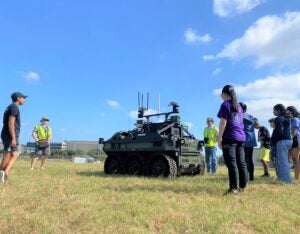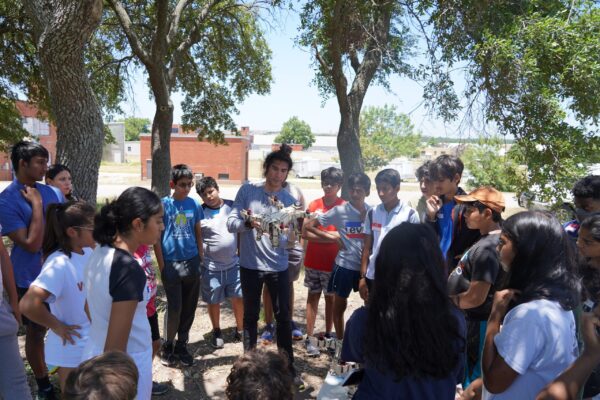A STEM enrichment camp at The University of Texas at Austin recently connected middle school students with tech mentors from the community and University and U.S. Army researchers who are solving complex national security problems. They learned about human-machine teaming through a leading-edge robotics demonstration, programmed small vehicles for an autonomous navigation challenge and built and tested drone prototypes.
Two cohorts of 7th-9th graders from across Central Texas attended the Gains in the Education of Mathematics and Science (GEMS) camp at UT’s J.J. Pickle Research Campus in North Austin to experience what it would be like to pursue a career in a STEM field. Students were taught engineering principles with a focus on AI and additive manufacturing and worked on team projects guided by a local STEM educator and high school mentors.
Spotlight presentations from University and Army subject matter experts were complemented by experiential activities such as a demonstration with cutting-edge technology that researchers from UT and the Army are working on together. Additionally, the Girl Scouts FIRST Robotics Competition Team, The Lady Cans, shared robot technology they have developed for a national competition.
GEMS is a U.S. Army-sponsored, summer STEM enrichment program for middle and high school students that takes place in participating U.S. Army research laboratories and engineering centers. Led by the U.S. Army Combat Capabilities Development Command Army Research Laboratory South (DEVCOM ARLSouth) and Army Futures Command, the program’s mission is to interest young people in STEM careers early enough that they can attain the appropriate academic training. The tuition-free program aims to serve students from historically underserved and underrepresented backgrounds in higher education.
The GEMS program is based on a multidisciplinary educational curriculum focused on age- and grade-appropriate hands-on STEM activities in areas such as science, engineering, mathematics, computational sciences, biomedical sciences, chemistry and biology.
“GEMS is not just a STEM camp — it’s a transformative experience, and we strive to inspire the next generation of innovators and change-makers,” said Corine Romero, GEMS summer camp lead. “Through hands-on experiments and engaging activities, our campers are immersed in a world of exploration and critical thinking.”

During the first week of camp, students used Python language to program their own AutoAuto self-driving cars and observed the operation of a large autonomous vehicle. After attending a safety training, campers gathered outdoors, where researchers from Texas Robotics, the hub for robotics activity at UT, performed a demonstration with a rugged 6×6-foot robot, the Hunter WOLF. They learned of the real-life challenges associated with AI vehicles and the power it takes to run an unmanned vehicle. Researchers encouraged the middle schoolers to consider the complexities of technological trade-offs and to ask questions about the vehicle and its operation.
“I’m glad that we had this opportunity to witness the immense potential within these young students,” said Blake Anderson, Texas Robotics researcher and demo leader. “By sharing the groundbreaking research conducted at our University, we hope to inspire them to pursue a STEM education and, ultimately, a career in scientific exploration. As they get a glimpse of our research and the exciting collaborative projects we undertake with institutions like the U.S. Army, they gain a sense of how their passion for science can translate into real-world applications and impactful contributions to society.”
During the second week of camp, students focused on additive manufacturing, physics and using engineering software and 3D printers to assist with the project design of mini catapults. Later, they worked in teams to build custom drone systems assisted by mechanical engineers from eVe Vehicles. As they assembled the prototype drones, students learned first-hand how all the parts of a four-propeller quad-copter work together and how they are calibrated to fly. After spending many hours troubleshooting, their quad-copters were finally airborne, piloted by technical mentors who shared industry tips and tricks.
Another goal of the GEMS summer program is to provide tools to volunteer teachers that enhance their classroom curricula and to keep camp participants engaged in STEM, creating a pipeline of educational and career exploration opportunities. As high school students, former GEMS campers can become Near-Peer Mentors. This year, four camp alumni from across Texas returned to serve as mentors and provided instruction and support, which helped to broaden their own view of STEM careers.
“The STEM community at the University and beyond is always thinking of ways to expand its reach, to attract even more students to pursue technical careers,” said Shannon Strank, assistant director of UT’s Center for Electromechanics and head of the GEMS summer camp. Strank is also ARL South Deputy and oversees collaborative research efforts in the region.
“I’m proud of what we’ve accomplished the past few years at GEMS camp and how our outreach network is growing,” Strank said. “We are leveraging resources by working with organizations in Austin and being able to share the work being done by the Army and our world-class research University. There is nothing like watching future innovators get a sense of what it’s like to work on a technical team, solving problems together.”




